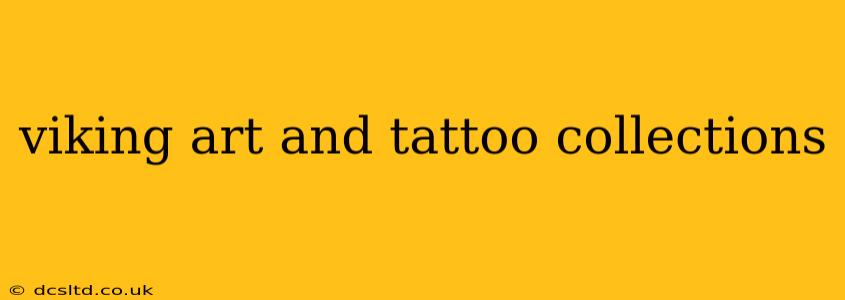Viking art and tattoos are experiencing a surge in popularity, fueled by a renewed interest in Norse mythology, history, and the aesthetic appeal of intricate designs. This exploration delves into the rich history and symbolism behind Viking art, examining its evolution and influence on contemporary tattoo collections. We'll also address frequently asked questions surrounding this captivating topic.
What are the main characteristics of Viking art?
Viking art, flourishing between the 8th and 11th centuries, is characterized by its distinctive style and recurring motifs. Key characteristics include intricate knotwork, interwoven animal designs (often incorporating serpents, dragons, and birds), and geometric patterns. These elements are often found in a variety of mediums, including wood carvings, metalwork (especially on weaponry and jewelry), and rune stones. The style is often described as dynamic and energetic, reflecting the adventurous spirit and powerful imagery associated with Viking culture. Unlike the more restrained and symmetrical art of some contemporary cultures, Viking art frequently embraces asymmetry and a sense of movement within the design. The use of zoomorphic (animal-shaped) forms is prevalent, reflecting a deep connection to the natural world and the animals vital to their survival.
What are some common Viking tattoo motifs?
Viking-inspired tattoos draw heavily from the artistic motifs found in historical artifacts. Popular choices include:
- Knotwork: Intricate and often endless patterns symbolizing eternity, connection, and the cyclical nature of life.
- Animals: Wolves (representing loyalty and ferocity), ravens (associated with Odin and prophecy), dragons (symbolizing strength and power), and serpents (representing wisdom and healing).
- Runes: The ancient Norse alphabet, with each rune carrying specific symbolic meaning and often used in tattoos to represent personal values or beliefs. Individual runes can be combined to create powerful statements.
- Valkyries: Female figures associated with battle and the afterlife, symbolizing strength, courage, and fate.
- Odin: The chief Norse god, often depicted with ravens or his eight-legged steed Sleipnir, representing wisdom, magic, and war.
- Thor's Hammer (Mjolnir): A powerful symbol of protection, strength, and fertility.
How did Viking art influence tattoo designs?
The influence is direct. Contemporary Viking-inspired tattoo artists draw directly from the historical designs found on artifacts, reinterpreting and adapting them for modern aesthetics. Many artists meticulously research historical pieces to ensure authenticity and accuracy in their work. While modern tattoos might incorporate color and stylistic variations not seen in original Viking art, the core motifs and design principles remain firmly rooted in the historical tradition.
Are there any specific symbols I should avoid in Viking tattoos?
While many symbols are generally considered positive, it’s crucial to understand the nuances of Norse mythology before choosing a design. Some symbols might have complex or negative connotations that aren’t immediately apparent. Thorough research and consultation with a reputable artist knowledgeable in Norse symbolism are essential to avoid unintentional misinterpretations or offensive representations. Avoid using symbols if you don't fully understand their meaning and implications.
What is the significance of runes in Viking tattoos?
Runes hold deep spiritual and cultural significance within Norse mythology. Each rune represents a specific concept or letter, and their arrangement can create powerful statements or personal mantras. The choice of runes for a tattoo should be carefully considered as their meanings can be deeply personal and impactful. Understanding the meaning of each rune is critical to ensure the tattoo accurately reflects the wearer's intentions and beliefs. It's recommended to work with an artist knowledgeable about runic symbolism to accurately and respectfully represent their intended meaning.
Where can I find more information about Viking art and tattoo designs?
Numerous resources are available for those seeking to learn more about Viking art and its influence on contemporary tattoo designs. Museums, academic journals, and specialized books offer in-depth analyses of Viking artifacts and their cultural context. Online resources, such as museum websites and reputable tattoo artists' portfolios, provide visual examples and detailed information on different design motifs and their associated meanings. Remember to always cross-reference information from several sources to ensure accuracy and depth of understanding.
By carefully researching and understanding the history and symbolism behind Viking art, individuals can create meaningful and authentic tattoos that celebrate this rich and fascinating culture. Remember to choose a skilled and reputable artist with experience in this style to achieve the desired results.
